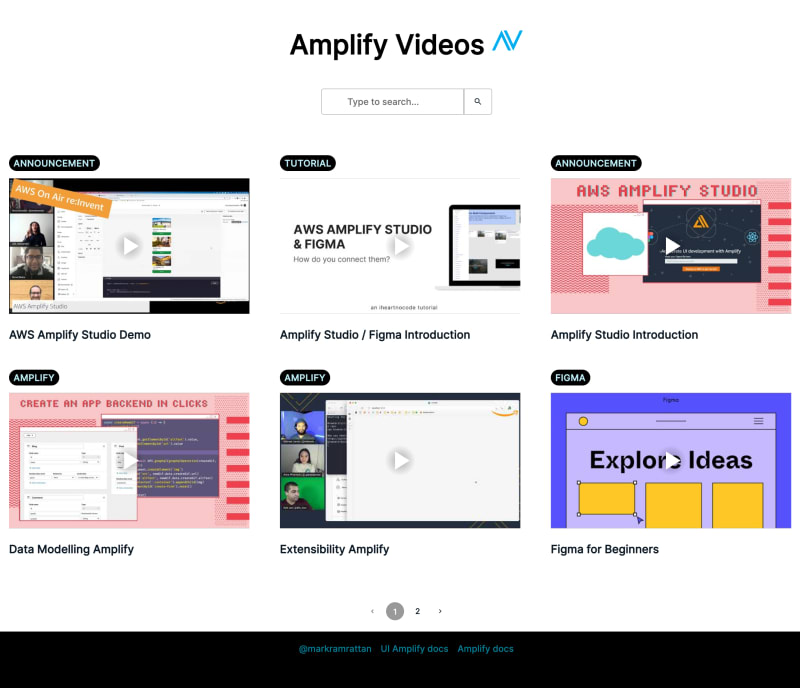Are you trying to learn more about AWS Amplify Studio? If your answer is Yes, then this guide may help you get a better understanding. Hopefully it will also help you keep track of related information around this new release. There are a few different videos, blogs, tweets popping up on Amplify Studio. I needed something to connect them all together (maybe you do too). We all know how fast it changes in this space and a guide can help keep this information in one place and relevant. As I find new resources / links, I'll be updating this same guide to keep it up to date :) If you have recommended resources, please do share them and I'll add them to this guide. Probably a good time to drop that famous African proverb:
If you want to go fast, go alone, but if you want to go far, go together
I'll be explaining and listing essential resources on Amplify Studio. We will also be taking AWS Amplify Studio for a test drive! Hopefully you will find value in this guide / blog. Even if it's just understanding concepts, please do follow along (at your own pace) and test it out with me. If you're not aware of this new update… let's explain below (feel free to skip this if you've already gone through it):
What is AWS Amplify Studio?
AWS Amplify Studio is a visual development environment for building full-stack web and mobile apps. Studio builds on existing backend building capabilities in AWS Amplify, allowing you to accelerate your UI development. With Studio, you can quickly build an entire web app, front-to-back, with minimal coding, while still maintaining full control over your app design and behaviour through code.
I like to think of amplify as a great way for you to go from idea to production ready app, fast. I also think this shift to Amplify Studio will help bring ideas to life for non developers too. Have you got a startup idea? I would recommend trying this out! Let's have a look at what resources are available to you:
Documentation Resources
- About Amplify Studio: https://aws.amazon.com/amplify/studio/
General information on Amplify Studio. Great for quickly understanding what it can be used for.
- Amplify Studio Docs: https://docs.amplify.aws/console/
This website is where most of the magic happens. It explains how to setup your Amplify (Studio) environment. Key concepts are explained, helping you to turn your idea into UI design, database modelling and binding your UI to data.
- Amplify UI Docs: https://ui.docs.amplify.aws
Great website for you to learn how you can use prebuilt UI design layouts and components within your app. This is a new feature and definitely worth checking out for inspiration!
- Understanding CSS: Flex Help
There are lots of properties now with UI / CSS aspects in the development and design of components and layouts. This website will help you fill in the gaps of what can be changed regarding design.
- What's New: AWS News Post on AWS Amplify Studio
General overview / announcement explaining region availability of Amplify Studio.
- Amplify Studio features written by @aspittel and @theswaminator
Great overview of eight new functionalities and features for Amplify Studio.
Tutorial Resources
- Launch Blog Tutorial: AWS Amplify Studio using Figma
René taking you through a tutorial from start to finish. Even if this is not aligned with your idea, doing this tutorial will help you gain practical understanding of key concepts.
- AWS Amplify Studio: Official Getting Started Tutorial
You should do this official tutorial! It’s really good and probably the best place to start if you don’t really want to read anything and just build, which is completely cool to do. We all learn and build differently.
- Build a Vacation Rental Site with Amplify Studio
Great tutorial that helps with all those nuances that don't get explained. Lots of extra links on the different steps to help plug those gaps.
- Matt's Amplify Studio Twitter Tutorial thread:
Great for understanding the steps quickly. Definitely recommended if you want to learn via Twitter.
- Anna's blog on: Building a Newsfeed with AWS Amplify Studio
Great to see a different use case tutorial! Brings in a deeper integration of how to do different layouts and social components (profile pictures, comments) integration.
- A Cloud Guru Tutorial: Create a Blog App with Studio
Ali showing us a different use case and includes building the app from a sandbox environment.
- Clojurescript Tutorial: How to Use Amplify Studio Figma Connector with Clojurescript by @rberger
Instead of being Javascript based, the blog shows how you can use Clojurescript for the project implementation. It does incorporate the Javascript output of Amplify Studio but all code to use it is in Clojurescript. Great work!
- (Ali Spittel) Figma to React to the Cloud: Build a Fullstack App with AWS Amplify Studio:
Using AWS Amplify Studio to generate React code from Figma components which are fully cloud-connected. Ali builds a blog app in this tutorial!
Figma Design Integration
One of the new features allows you or graphic designers to develop your app design in Figma and integrate within Amplify Studio. Let's take a look at this integration.
Figma is a free, online UI tool to create, collaborate, prototype, and handoff your application design. Amplify Studio offers an integration with Figma, allowing you to generate reusable React code by importing your Figma design file. Amplify Studio automatically converts any Figma component in your Figma file to a React component that can then be used in your app. Whenever you make a change to the component in Figma you sync the changes to Amplify Studio and update your application!
There are 4 introduction videos here on how to use Figma. If you're like me, this is all new. I'm used to graphic designers working in adobe photoshop, illustrator etc and sending it to front-end developers (me) and then I would translate that into production. Using Figma is a new way for me to improve the design -> development process.
Let's GO! & Build a Solution (MVP)
The above is a lot of information to digest. We are not stopping there... (stick with me!) and yes we could probably split this into a series, though we have all these resources and we've got nothing tangible... We need to build something with all this knowledge!
I was in the Amplify Extensibility sessions and a few people commented "Is there anywhere on the web with all the amplify videos in one place?" I replied, "I've not seen one and could easily create a youtube playlist to encapsulate them all." Let's create a place (solution) to view all Amplify Studio videos.
Yep, we are going to build an app to hold all of our Amplify Studios videos. Yes, that sounds like Inception, building something for Amplify with Amplify. We need this solution, to give other users CRUD access to update / manage the content (Amplify Studio enables this functionality). That's enough talking, let's GO!
Step 1: Load up an App in Amplify Studio
Lots of different ways to do this, I've gone via AWS Management Console, then locate AWS Amplify and select New app -> Build an App. You should see the below screen, I've called my app 'Amplify Studio Learning'. Select Confirm Deployment.
Step 2: Launch Amplify Studio
Once it loads, you'll see 'Launch Studio' button in the backend tab. Click that button, though check if your pop up is blocking it from opening (always happens to me, in chrome!).
If you've been using Amplify recently, you'll notice, Amplify Studio looks exactly like Amplify Admin UI and you would be correct ;) What's better than a new service, a service that's been refined and improved over time. I digress, let's get back on it!
Step 3: Data modelling & Adding Data
Select the Data tab on the left, we are going to do some data modelling. Mine looks like this:
If you've gone through the other tutorials, this will be familiar to you. I've added fields for video url, name and type. Once you're happy with your data structure, click "Save and Deploy". This is where Amplify builds it all out for you in the background. Once done, head over to the content tab. Mine looks like this:
Yes we can add auto generated data, though you're on route to production / being a pro, put in some real data. I've inputed some Amplify Studio videos that are essential viewing. Once done, it's time to introduce Figma (Design). Click the Home menu and select the 'Build UI' button. Or click the UI Library tab and select Get Started button.
Step 4: Open up Figma
Clicking the Get Started button will open up the link to: Figma - Amplify Studio Template. Click duplicate and select My Components. You'll see the available components. I've customised CardE.
Feel free to adjust your component the way you would like it. Once you're happy with the design. Click the Share button in the top right and copy the link.
Step 5: Sync Amplify Studio with Figma
Once you've got your link, you need to switch back over to Amplify and paste the link in the UI Library (tab) area and click Continue. This will prompt you to sign in with Figma, allow access and sync the files. I normally accept all, it's quicker. Then all your components will be available for you.
Once that is done, you will see all the components loaded from Figma in your Amplify UI Library tab. Here is what mine looks like:
Step 6: Configure & Bind Data to Components
Awesome, it's looking good. Notice I've highlighted the Configure button in the above image. We now need to turn our design into a collection and bind the data to our design. Click Configure and you'll now be able to do this:
Groovy! Add in your model name in the Type. Select the top level Component (CardE) and input that in and give it a name (mine's 'Info'). Go through your other elements and connect them up. The property on text is 'label' and the value would be 'Info.name'. This will be different for you, depending on what you've named your data model and component name. Once you're done connecting it up, click Create Collection and give it a name (mine's 'CardECollection').
Step 7: Adjust Layout and Get Component Code
Here you can adjust the layout, spacing and order for your collection. On the left, I've selected 'Grid' and added 10px around each card. On the right you can adjust the order. I've added a sort filter via Name to be ascending, which will keep the content displayed in a logical order. Feel free to do the same or make it your own. Coolio 😎, that's done! We now need to import this into our app locally to test it out. Click '</> Get component code' This brings up a handy prompt of what we need to pull locally into our amplify app.
Step 8: Create App Locally & Sync with Amplify Studio
Create your React app locally. You can do this with running the following command in Terminal:
npx create-react-app amplify-demo
Move into the React app that you've just created:
cd amplify-demo
Remember that section with the 'initial project setup' guide. Run those commands:
npm install -g @aws-amplify/cli
npm install aws-amplify @aws-amplify/ui-react
Once done, you'll need to switch to the other tab instruction and pull the Amplify Studio code into your project. Mine looks like this:
amplify pull --appId d22vmom8abyhk2 --envName staging
In your App.js file add:
import { CardECollection } from './ui-components';
Place your collection where you would like it to be displayed:
<CardECollection />
My App.js looks like this:
Step 9: Override & Extend Generated Code - React Player
I know what you're thinking, wait a minute what happened to CardECollection in your code? Don't worry it's there, I've renamed it and it's called 'PlayerCollection.' Why have I done this? Remember at the start we are trying to allow users (you and me) the ability to watch videos. There is no video component integrated (yet). When you use a default component, any changes will be overwritten when you re-sync with Figma. Take a look at this Modify Generated Code Override. This explains how to do this change and also everything we've gone through so far is within that documentation. Take the time to explore the docs too.
I used and installed this (React Player):
npm install react-player
Then within your CardE component import the React player. Change the url to your corresponding path in your data model. Mine would be: url={Info?.video}
import ReactPlayer from 'react-player'
// Render a Video Player
<ReactPlayer url='https://www.youtube.com/watch?v=ysz5S6PUM-U' />
Remember that grey box in my CardE design on Figma. I've made the React Player to be the same size and it fits nicely within that area. Here's what my Player / CardE component looks like:
Now that's added, we should load up the React server and check what this looks like...
npm start
Mine looks like this:
Take a moment to reflect... if you've followed along. You've just turned an idea into a real, working product. AMAZING! Well Done! You've not only created an MVP, you are the MVP! All we do now is wait for Venture Capitalists to invest ;) or integrate your own payment model and bootstrap your startup. If you feel like helping to add more videos to our Amplify Videos app, feel free to connect with me. I'll add you to Amplify Studio content management section. You can add more videos and help the community learn more about Amplify.
Summary
I really like the direction AWS Amplify (Studio) is going. If you've got a startup idea or need to develop a solution to a problem, with an AWS service, Amplify Studio is a good option. Yes, the learning curve does take time (each person is different). I would encourage you to stick with it, the rewards are exponential when you understand how it all connects. Yes, it isn't a no-code solution and it does take time to up-skill. We've seen a deeper design integration which will exponentially help us reduce the time it take to move from idea to production ready app. I hope you found this guide useful. Leave a comment or tweet me @markramrattan with any questions or resources you think could be added. You can also join the Amplify Discord if you need help... They are superheroes!
Clean Up
To clean up your Amplify project, run:
amplify delete
Or via the Amplify Web Console, go Actions -> Delete app:
Wishing you a healthy and happy new year! I'm looking forward to seeing what you build in 2022.
Figma File Link @zachjonesnoel
Extra
If you want to take it a step further. Check out my other blog, it shows you how to integrate Chat and GEO within your Amplify App. That would be a cool extra integration:


Build a serverless, real-time application with modern APIs: The GraphQL Real-time Race
Mark Ramrattan for AWS Community Builders ・ Jun 29 '21
Editor: Dr Shivani Kochhar


























Top comments (10)
Great tutorial. Its helpful that you went a little more in depth than some of the other tutorials on Studio.
For those who would like to use Clojurescript with Amplify Studio check out dev.to/aws-builders/how-to-use-amp...
That's my thinking too. Needed something more in-depth to help move past the parts where we get stuck. Might do a video version of this guide, what do you think? I'll also add in your link to this guide too.
That would be great
Wonderful read!! Yes, have been trying out Amplify Studio from a couple of days and I'm truly impressed and have fallen in love with it.
Thank you @zachjonesnoel What have you been building with Studio?
I've added a link to the Figma file template for my CardE to the bottom of the guide.
Awesome!! Thanks @markramrattan
I'm building a web app which contains a link to all my blog posts and sessions. 😜 Was making something similar to the collection you got but Figma is new to me struggling with it a bit. 😅
Same, it's new to me too. Took me 15mins (inc googling) to figure out how to Bold text 😂 I've spent way too much time in Adobe / Office365 😅
Can you push locally modified code back into the Studio project? I’m wondering if it can be used as a CMS or if modifying local code prevents Studio from being able to make additional changes. Hoping to hand the project off to non-developers